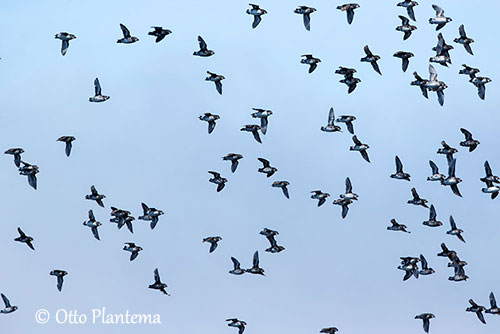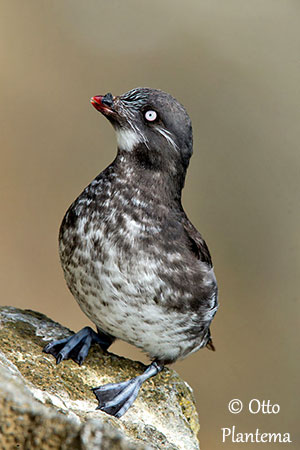
Fr : Starique minuscule
Ang : Least Auklet
All : Zwergalk
Esp : Mérgulo Mínimo
Ita : Alca minima
Nd : Dwergalk
Sd : Dvärgalka
Photographers:
Ken Havard
My Bird Gallery & Flickr gallery 1 & Flickr gallery 2
Otto Plantema
Trips around the world
Text by Nicole Bouglouan
Sources:
HANDBOOK OF THE BIRDS OF THE WORLD Vol 3 by Josep del Hoyo-Andrew Elliott-Jordi Sargatal - Lynx Edicions - ISBN : 8487334202
BirdLife International (BirdLife International)
Alaska Seabird Information Series
Animal Diversity Web (University of Michigan Museum of Zoology)
What Bird-The ultimate Bird Guide (Mitchell Waite)
Wikipedia, the free encyclopaedia
Least Auklet
Aethia pusilla
Charadriiformes Order – Alcidae Family
INTRODUCTION:
The Least Auklet is the smallest of the auklets, with a length of 15 centimetres. It comes to land only for breeding on remote islands and sea coasts in Alaska. It spends the winter in open water.
This species is one of the most abundant seabirds in the world. It is a voracious eater, consuming about 90% of its body weight in food each day.
Like numerous seabirds, the Least Auklet is threatened by hunting and egging, destruction of the habitat, introduced predators, human disturbances and marine pollution. But currently, it is still very common throughout its range.
DESCRIPTION OF THE BIRD:
Biometrics:
Length: 14-16 cm
Weight: 85 g
The adult has dark upperparts, black to brown, with variable white patches on the scapulars.
The underparts are white to dark grey mottled paler grey. The chin is black but the throat is white. We can see a dark, variably mottled breast band.
The head is dark. In breeding plumage, we can see white bristly feathers on forehead and lores, and some other fine white plumes projecting back from the eye.
The short bill is reddish with blackish base and pale tip. There is a small, horny, blackish knob at base of upper mandible, projecting vertically from the upper bill. The eyes are white. Legs and webbed feet are bluish-grey with blackish webs and black claws.

Both sexes are similar, but the female has shallower bill. During winter, their underparts are entirely white. The bill is mostly blackish. Knob and most facial white plumes are absent.
The juvenile is similar to non-breeding adult, but the white auricular plumes are absent.
RANGE:
The Least Auklet occurs in N Pacific. It breeds on the Chukotski Peninsula of E Siberia, west coast of the Kamchatka Peninsula, Commander Islands, central Kurile Islands, and on islands in the Sea of Okhotsk.
During winter, it can be seen at sea along the coasts in the Bering Sea. It often remains near the breeding areas. It moves from N limits of ice-free waters, S to Gulf of Alaska and N Japan (especially Hokkaido).
HABITAT:
The Least Auklet breeds on rocky beaches, sea-facing slopes, sea cliffs, boulder fields and lava flows on remote islands. The highest concentrations of nests are usually on bare talus.
CALLS AND SONGS: SOUNDS BY XENO-CANTO
The Least Auklet is very vocal at breeding colonies. The adults can produce various types of sounds such as chatter, chirp, and chirr-buzz, uttered while rocking slightly the head.
BEHAVIOUR IN THE WILD:
The Least Auklet has a large appetite and consumes about 90% of its weight per day in small zooplankton and marine invertebrates. It forages near the shores to offshore locations all year round, and often in large flocks.
During the breeding season, adults and chicks feed mainly on copepods, and especially Neocalanus plumchrus, and other small crustaceans. Like other auklets, the adults carry the food in their sublingual pouch.
The Least Auklet dives from the surface and forages underwater, propelling itself with the wings like an underwater flight.
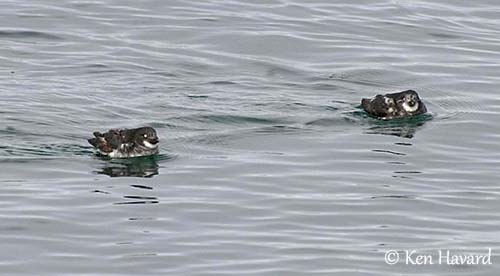
During the breeding season, it breeds in huge colonies which may contain hundreds of thousands birds. They are monogamous, but unlike other auklets, there is fairly low mate fidelity. Both sexes choose partner with the most elaborate and conspicuous facial ornaments.
Some displays are performed prior to copulation. The male in low-hunched posture runs in a circle around the female while uttering continuously a chattering vocalization. This display is fairly similar to a rodent-run display!
Due to the large aggregations, they have a wide repertoire of signals and social behaviour, and social signals are divided into sexual and territorial behaviour.
Although densities in colonies involve better protection against predators, the small Least Auklet is vulnerable to competition for nesting sites, and can be displaced from its nest-site by the larger Crested Auklet.
The Least Auklet spends autumn and winter at sea. It often remains near its breeding areas year round in ice-free waters.
Some movements S into N Pacific are reported, and it can reach N British Columbia and N Japan (Hokkaido).
The flight is swift, strong and direct.
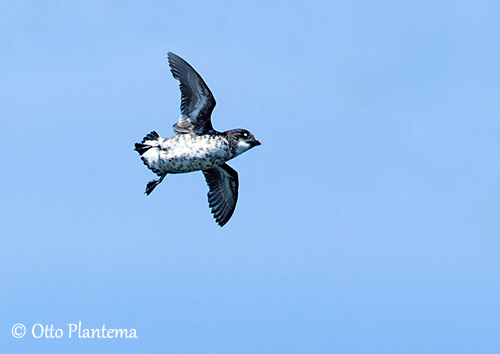
REPRODUCTION OF THIS SPECIES:
The breeding season occurs between June and August.
The Least Auklet breeds in huge colonies established on remote islands, on rocky beaches, sea-facing slopes, boulder fields and lava flows.
The nest is placed inside rock crevices or other natural cavities. It is unlined.
The female lays a single white egg on bare, flat surface inside the nesting cavity. Both parents share the incubation during one month, in shifts of 12-36 hours.
At hatching, the chick has brown down above and greyish-brown below. Both adults brood it during the first week and feed it with the food carried in their sublingual pouches. The young fledges 26 to 31 days after hatching. It is independent when leaving the colony.
Foxes, voles and rats take eggs and chicks at nest. When fledged, the juvenile is vulnerable to predation by gulls and foxes.
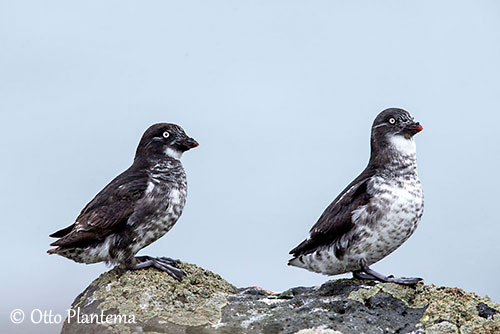
PROTECTION / THREATS / STATUS:
The Least Auklet is vulnerable to usual threats such as predation by gulls and mammals, hunting and egging in Alaska, drowning in fishing nets, human disturbance at colonies and oil pollution.
The global population is estimated at about 24,000,000 individuals, and suspected to be in decline due to previous threats.
But currently, the Lest Auklet is evaluated as Least Concern.
